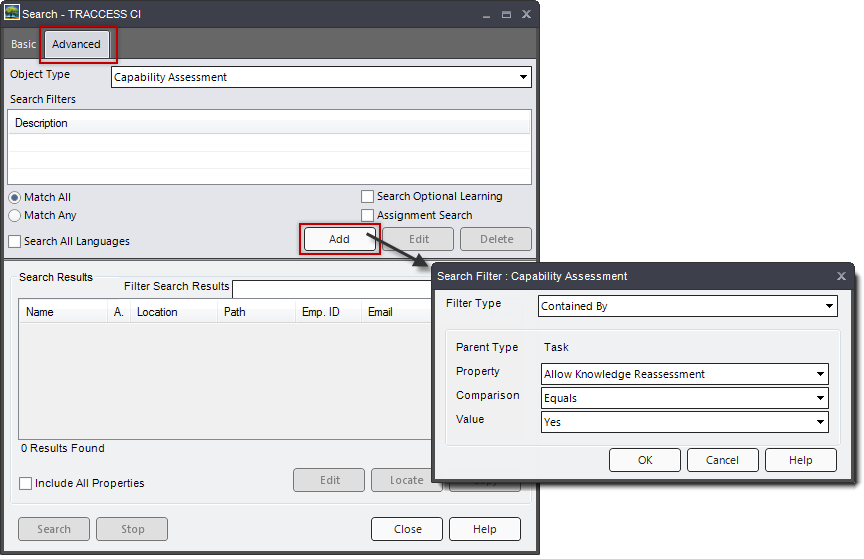|
|
|
|
Understand the Advanced Search Functions
The advanced search allows you to create filters for a selected object in the system that you want to search for. The more filters you create, the more you can narrow down your results. Filter Types can be set by object Property, what the object Contains, what the object is Contained By, or what/who the object is Assigned To. For example, you can search for Knowledge Assessments that are online and contain radio select answer styles. You can also easily manage your filters, and once you have conducted your search, you can jump to a specific object in the system from your search results.
To access the advanced search, click on the Search ![]() icon in the Quick Access Bar, and then click on the Advanced tab in the Search dialog. Click the Add button to add filter, as shown in the image below:
icon in the Quick Access Bar, and then click on the Advanced tab in the Search dialog. Click the Add button to add filter, as shown in the image below:
click image to enlarge - double-click to resize

There are several filter types available to help narrow down your search results:
Property - Searches for an object based one or more of its properties.
Contains - Searches for an object based on an object it contains.
Contained By - Searches for an object based on its parent object.
Assigned To - This option is only available when the "Assignment Search" checkbox is enable in the Advanced tab. This allows you to search for objects based on the objects they are assigned to.
Examples of Filters and how to manage them is explained here.
You will use the functions in the Advanced tab of the Search dialog to add filters and conduct your search. The parts of this dialog are explained below:
click image to enlarge - double-click to resize

A. Object Type - Choose the type of object you are searching for.
B. Search Filters/Description - Lists the filters added from the Search Filter dialog box.
C. Match All - If you indicate more than one search filter, this option indicates that all search requirements must be met.
D. Match Any - If you indicate more than one search filter, this option indicates that any search requirements can be met.
E. Search Optional Learning - Includes Optional Learning in the search.
F. Assignment Search - When enabled, allows you to use the "Assigned To" Filter Type.
G. Search All Languages - Searches all languages in the system rather than only the currently selected language.
H. Add - Allows you to add a Search Filter.
I. Edit - Select a Search Filter from the Description box, and click this button to edit.
J. Delete - Select a Search Filter from the Description box, and click this button to delete.
K. Filter Search Results - Type in a keyword(s) to filter the search results. You may also use regular expressions in this field.
L. Search Results - Displays the results of your advanced search after clicking the Search button.
M. Include All Properties - When unchecked, all of the object's properties will also be shown in the search results.
N. Edit - Brings up the Multi-Object Property Editor, where managers can edit the objects properties.
O. Locate - Click on a search result, and then click Locate to jump to that object in the system.
P. Copy - If you would like to further manipulate the search results, use the <Shift> and <Ctrl> keys to select specific search results, and click Copy. You can then paste the contents of the clipboard into another application (e.g., Notepad, Microsoft Word, or Microsoft Excel).
Q. Search - Starts the search.
R. Stop - Stops a search in progress.
The Search dialog appears. ![]()
The Search Filters dialog appears. ![]()
Depending on the Object and Filter Type selected, you may see several dropdown menus. These selections you make will determine the uniqueness of your filter. Some dropdown options show a Value field, where you must enter a specific value. For more information, visit Search Filters.
The filter appears in the Description box.
The Match All option is selected by default; therefore, if you have more than one filter created, this indicates that you wish to only retrieve results that match all of the filters that have been set.
The Search Results dialog will be populated.
The program will navigate to the selected Search Result.
Additional Help: